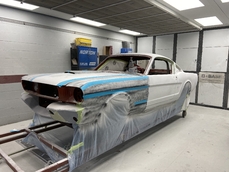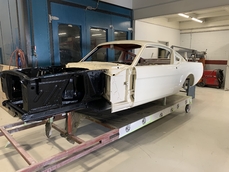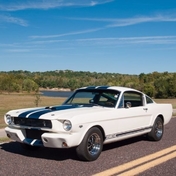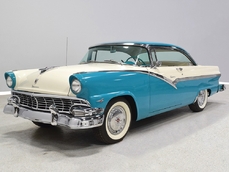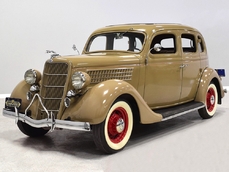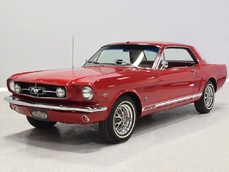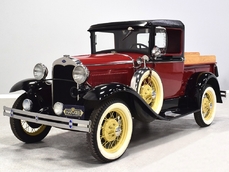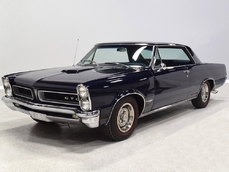Shelby GT 350 302 cubic inch V8 1965
Allgemeine Beschreibung :
The Ford Mustang was a huge success by any measure, but there was a persistent image problem that worried marketing bosses: was it hardcore enough to attract serious horsepower fans? Fortunately, the cure for the “secretary’s car” image was as easy as a phone call to partner Carroll Shelby, who eagerly turned the all-new Mustang into a lean, mean track machine. The GT350 was for the street but had the hardware to live on the track, but for the guys who didn’t want a blurry line between street and track there was the GT350R. Stripped down, razor-edged, and built without any pretense of being a dual-purpose car. If you wanted a fast Ford for the track, the R was the hot ticket. Today, R-models command hefty 6- and 7-figure prices, indicative of being really, really good at their job. So if you’ve always wanted one but don’t have that kind of budget, we respectfully submit this rather well done 1965 Mustang GT350R tribute, which gives you 90% of the flavor at 10% of the price. Pretty hard to beat that combination.
Created from an A-code fastback, this was already a fairly serious performance car before the transformation. The upgrades aren’t quite as hard-edged as Shelby’s, and there’s no secret about this tribute being built for the street. That means no low-hanging oil cooler in the R-spec front bumper, a reasonable exhaust system, a comfortable ride, and an interior where you won’t mind spending some time. Fit and finish are excellent and the car certainly has the right look, including Wimbledon White paint with Guardsman Blue stripes, the aforementioned R-model front bumper, hood scoop, Shelby grille, and a killer stance. We can find no evidence that this was a rusty car in its previous life and it fits together rather well today. Doors swing closed with a reassuring sound and despite the Mustang’s reputation for rusting in some rather demonic ways, we can find no evidence of it. It appears to have its original quarters, the cowl isn’t patched or rotted, and the rockers are in excellent shape. There’s also a period-appropriate gloss to the paint that lends an air of authenticity. The only thing missing are the GT350 stripes along the rockers, but that’s an easy upgrade if it’s a look you want.
The interior remains basic Mustang—functional and comfortable but not a lot of frills. Low-back bucket seats wear standard seat covers (they would have been tossed before their first day at the track anyway) and as a tribute, this car has full carpets and sound deadening, so it’s reasonable on the street. Shelby added his own wood-rimmed steering wheel, which has been replicated here, as well as a trick gauge pod in the center of the dash for an oversized tach and oil pressure gauge. The rest of the instrumentation is standard Mustang, which is how the Shelbys were outfitted from the factory, and heavy-duty seat belts were added for a racy feel. There’s also a Hurst cue ball shifter for the Toploader 4-speed underneath, and it snaps through the gears with awesome mechanical precision. No radio, no A/C, no power steering, so if you’re the sort of guy who needs this stuff, well, there are other Mustangs. On the other hand, the custom shelf that eliminates the back seat and moves the spare tire inside the car was purely for weight distribution purposes and it probably worked rather well (it’s worth noting that the spare in this car is just a prop and does not include a wheel). The actual trunk is neatly outfitted with a correct mat and shows zero evidence of trauma or rust in its recent past.
Ford’s venerable small block V8 was the cornerstone of Shelby’s performance image, and it appears that this GT350R is carrying a 289 cubic inch unit that’s been built to feel and sound like the real thing. There’s a bit of a cam inside to give it a performance car idle and that huge mid-range pull that made these cars so fun to drive. On top there’s a big 4-barrel carburetor with a correct open-element air cleaner. Shelby added the Monte Carlo bar to reinforce the front shock towers, so that was installed here as well, along with a giant aluminum radiator up front. Finned valve covers and correct black engine enamel finish the look. It’s also nicely tuned, so it starts easily, idles properly, and does indeed pull this Mustang around with real enthusiasm. There’s an awesome bark from the side exhaust that winds into a viscous snarl as you accelerate, but it never gets unruly or fussy on the street. This is a tribute car built for the way it’ll be used—on the street.
Underneath you’ll find very clean floors and familiar Mustang hardware. The Toploader 4-speed feeds a sturdy 8-inch rear end with what feel like 3.50 gears—punchy but not too extreme for regular use. Tri-Y headers are the right choice and dump into a set of glasspack-style mufflers before exiting ahead of the rear wheels, as original. The front suspension is unmodified save for a giant sway bar, and as I mentioned, both the brakes and the steering are manual so it takes a little muscle to handle this R model. Not bad, not too much that you can’t manage it, but it’ll take more than a fingertip to park it. There’s a lot of new hardware throughout, including lines and hoses, U-joints, and an upgraded rear sway bar that sharpens handling considerably. Of note, the torque boxes are excellent and don’t show any evidence of previous abuse or rot, and the spring/shock combination is just about right for a fun street car. A new gas tank was installed during the restoration and it sits on modern Billet Specialties wheels and staggered 15-inch radials that do a pretty good impersonation of vintage Torque Thrusts and Goodyear gumballs.
The beauty of the tribute car is the ability to enjoy an experience that you would otherwise never be able to reach financially, all without the concerns of damaging a priceless automotive artifact. This cool Mustang snarls and barks, leans into corners, and has all the right feels coming through your palms, yet is priced about the same as any other restored A-code fastback. The balance between authenticity and streetability is just about right and few early ponies can attract the kind of attention this car generates. If that’s your kind of fun, this is your kind of car. Call today!
Harwood Motors always recommends and welcomes personal or professional inspections of any vehicle in our inventory prior to purchase.
http://www.harwoodmotors.com/vehicles/inventory_details.php?id=1327
1965 Shelby GT 350 302 cubic inch V8 is listed verkauft on ClassicDigest in Macedonia by for $59900.
Fakten der Auto
Karosserietyp : Auto Marke : Shelby Modell : GT 350 Ausführung : 302 cubic inch V8 Hubraum : 0.0 Modelljahr : 1965 Karosstyp : Pick up Lage : Ohio
Verkauft
Angaben Zum Verkäufer
Verkauft
People who viewed this Shelby GT 350 also viewed similar Shelby listed at ClassicDigest
Other cars listed for sale by this dealer
über Shelby
Carroll Shelby, eine legendäre Figur in der Automobilwelt, hatte einen bemerkenswerten Weg vom erfolgreichen Rennfahrer zum renommierten Sportwagenhersteller in den Vereinigten Staaten. Seine Geschichte ist voller Erfolge, Innovationen und ikonischer Autos, die einen unauslöschlichen Eindruck in der Branche hinterlassen haben.Frühe Jahre und Rennkarriere:
Carroll Shelby wurde 1923 in Texas geboren. Während des Zweiten Weltkriegs verfolgte er zunächst eine Karriere als Pilot, entdeckte aber nach dem Krieg seine wahre Leidenschaft im Rennsport. Shelby wurde in den 1950er Jahren ein erfolgreicher Rennfahrer und nahm an verschiedenen Veranstaltungen teil, darunter der Formel 1, Langstreckenrennen und den berühmten 24 Stunden von Le Mans.
Shelby Cobras – ikonische Sportwagen:
Carroll Shelbys entscheidender Moment als Hersteller kam mit der Entwicklung des Shelby Cobra, einem legendären amerikanischen Sportwagen. Die Cobra entstand aus der Fusion eines britischen AC-Ace-Chassis und eines Ford-V8-Motors und schuf ein leichtes Hochleistungsauto, das sowohl auf der Rennstrecke als auch auf der Straße dominierte. Zu den wichtigsten Modellen gehören:
Shelby Cobra 260 (1962): Die erste Version mit einem 260 Kubikzoll (4,2 l) V8-Motor.
Shelby Cobra 289 (1963–1965): Spätere Versionen mit einem 289-Kubikzoll-V8-Motor (4,7 l), einschließlich der Cobras mit Wettbewerbsspezifikation, die für ihre Rennfähigkeiten bekannt sind.
Shelby Cobra 427 (1965–1967): Die stärkste Version mit einem 427 Kubikzoll (7,0 l) V8-Motor, bekannt für seine rohe Kraft und Leistung.
Ford-Partnerschaft – Shelby Mustangs:
Shelbys Partnerschaft mit Ford führte zur Entwicklung der legendären Shelby Mustangs. Das bemerkenswerteste Modell ist:
Shelby GT350 (1965–1969): Basierend auf dem Ford Mustang wurde der GT350 von Shelby American modifiziert und zeichnete sich durch verbesserte Leistung, Handling und unverwechselbares Design aus.
Weitere bemerkenswerte Modelle und Erfolge:
Neben den Cobras und Mustangs leistete Shelby noch weitere bedeutende Beiträge:
Shelby Daytona Coupé: Dieses Auto wurde für den Sieg gegen Ferrari im internationalen GT-Rennsport entwickelt und war 1965 das erste amerikanische Auto, das die FIA GT-Weltmeisterschaft gewann.
Shelby Series 1: Ende der 1990er Jahre eingeführt, war dies Shelbys moderne Interpretation eines Hochleistungssportwagens.
Der Ford GT40 spielt in Carroll Shelbys Erzählung eine zentrale Rolle, insbesondere in Bezug auf seine Verbindung zu Ford und seinen bedeutenden Beitrag zum Erfolg des Autos.
Die Entwicklung des Ford GT40:
Fords Herausforderung:
Anfang der 1960er Jahre versuchte Henry Ford II, Ferrari zu erwerben, doch die Verhandlungen scheiterten. Dies bestärkte Ford in seiner Entschlossenheit, Ferrari beim prestigeträchtigen Langstreckenrennen 24 Stunden von Le Mans zu schlagen, das Ferrari mehrere Jahre lang dominiert hatte.
Zusammenarbeit mit Shelby:
Ford wandte sich an Carroll Shelby und schätzte dessen Rennsportkompetenz und Erfolgsbilanz. Shelby wurde damit beauftragt, das GT40-Projekt zu leiten und daraus einen konkurrenzfähigen Rennwagen zu machen, der Ferraris Vormachtstellung herausfordern konnte.
Entwicklung und Triumph:
Unter Shelbys Anleitung wurde der Ford GT40 einer gründlichen Entwicklung unterzogen, um anfängliche Designfehler und Leistungsprobleme zu beheben. Es wurden mehrere Iterationen erstellt:
Frühe Versuche: Die ersten Versionen des GT40 hatten Probleme mit der Zuverlässigkeit und dem Handling, was 1964 zu enttäuschenden Ergebnissen in Le Mans führte.
GT40 Mark II: Shelbys Team hat entscheidende Verbesserungen vorgenommen. Der Mark II, ausgestattet mit einem leistungsstarken V8-Motor, verbesserter Aerodynamik und verfeinerter Technik, wurde äußerst konkurrenzfähig.
Le-Mans-Sieg:
1966 errang der Ford GT40 Mark II einen historischen Sieg bei den 24 Stunden von Le Mans, wobei der von Shelby trainierte Fahrer Ken Miles das Rennen anführte. Dies war der erste Sieg eines amerikanischen Herstellers in Le Mans und brach damit die Dominanz von Ferrari.
Anhaltenden Erfolg:
Der GT40 dominierte weiterhin und gewann in den folgenden drei Jahren (1966–1969) Le Mans, sicherte sich seinen Platz in der Renngeschichte und festigte Fords Ruf als Kraft im internationalen Motorsport.
Shelbys Beitrag zum GT40-Erfolg:
Obwohl Carroll Shelby nicht direkt an der Entwicklung des GT40 beteiligt war, trugen seine Erfahrung im Rennsport und seine Fähigkeit, ein Team aus talentierten Ingenieuren, Mechanikern und Fahrern zusammenzustellen und zu leiten, entscheidend zur Verbesserung der Leistung des Autos bei. Sein Einfluss trug dazu bei, technische Probleme anzugehen, das Fahrverhalten des Autos zu verfeinern und Renntaktiken zu entwickeln, was maßgeblich zum Erfolg des GT40 auf der Rennstrecke beitrug.
Vermächtnis und Auswirkungen:
Die Siege des Ford GT40 in Le Mans unter Shelbys Führung gehören nach wie vor zu den ikonischsten Errungenschaften in der Geschichte des Motorsports. Der Erfolg des Autos festigte Shelbys Ruf als Automobilvisionär und stärkte seine Partnerschaft mit Ford weiter.
Carroll Shelbys Beteiligung am GT40-Projekt stellte seine Fähigkeit unter Beweis, ein schwieriges Projekt in eine Maschine zu verwandeln, die die Meisterschaft gewann, und fügte seiner illustren Karriere in der Automobilwelt ein weiteres bemerkenswertes Kapitel hinzu.

















